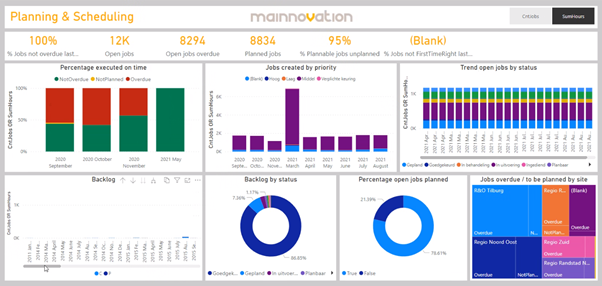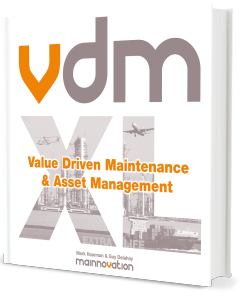Confucius as a Maintenance Manager
ArticlesSharing KPIs leads to improvement
Confucius, the Chinese philosopher, taught us an important lesson regarding cooperation, leadership and growth: ‘Tell me and I forget, show me and I remember, involve me and I understand’. Confucius died in 479 BC, so this was not about data, KPI insights and asset performance. However, it is well worth to philosophise about this.
With KPIs (Key Performance Indicators) you can monitor, analyse and improve the performance of your organisation and your assets. But which KPIs are relevant? What does a certain number mean? And isn’t drawing up a good KPI dashboard extremely labour-intensive?
Find opportunities
To give an answer tot he last question: No, it is actually very simple, provided the Enterprise Asset Management system (EAM) is properly filled. This starts with a solid Asset Register. A complete listing of your physical resources. Relevant information is linked to these assets, including technical characteristics, costs, failures and resolution times. But also maintenance and inspection plans. This information is processed in the EAM system.
Mark Haarman, managing partner of Mainnovation: ‘The information we collect in our EAM system – whether this is complete or not – there is value in it, which we are not yet making sufficient use of. We have input from years, without extracting valuable output from it.’ When the EAM system is properly set up, the dashboard is automatically generated. ‘It is almost a matter of ‘plug and play’ for the existing EAM system.’
Back to Confucius. By the way, this is also the man who said: ‘Study the past, if you would define the future’ and 2.500 years later this philosophy is surprisingly applicable. After all, with modern techniques we can study ‘the past’ well. The insights and knowledge about the current state and performance of the assets, provides tools to be able to define actions for the future. ‘By targeting KPIs, we uncover the improvement potential. We measure and monitor, register the required data and we can adjust and improve.’
Dashboard for the entire organisation
 Mainnovations VDMXL Control Panel (VCP) is a KPI dashboard not only for management, but for the entire maintenance and asset management department. The VCP is built in modern Business Intelligence-software and it is integrated with the EAM system of the company. Haarman: ‘With data from SAP EAM, IBM Maximo, Infor EAM or Ultimo, the 12 KPIs are calculated and visualized in real time. In addition, the Control Panel contains a separate dashboard for six underlying PIs for each KPI.’
Mainnovations VDMXL Control Panel (VCP) is a KPI dashboard not only for management, but for the entire maintenance and asset management department. The VCP is built in modern Business Intelligence-software and it is integrated with the EAM system of the company. Haarman: ‘With data from SAP EAM, IBM Maximo, Infor EAM or Ultimo, the 12 KPIs are calculated and visualized in real time. In addition, the Control Panel contains a separate dashboard for six underlying PIs for each KPI.’
The dashboard can be set up based on personal preferences. ‘A planner needs different insights than a mechanic, a maintenance manager or the CFO of a company. With this dashboard, everyone gets the control instruments relevant to him or her.’ The VCP can therefore be used at all levels of the company. ‘And Confucius has very nicely indicated why this is important. He says: ‘Tell me and I forget, show me and I remember, involve me and I understand’. When employees understand why results are the way they are, they start thinking about how these results can be improved. So by actively involving them, by giving them more insight, the technical department changes from a cost center to a business function that continuously adds value to the operating result. We strongly believe this’, says Haarman.
VCP for Ultimo
![]() In close collaboration with Ultimo, Mainnovation created a new version of the VDMXL Control Panel especially for Ultimo. With its flexible EAM cloud platform, Ultimo helps customers increase asset uptime, manage costs, extend asset life, comply with laws and regulations and ensure a safe working environment. The Ultimo EAM platform is now integrated with the VDMXL Control Panel based on Microsoft Azure and Microsoft Power BI technology.
In close collaboration with Ultimo, Mainnovation created a new version of the VDMXL Control Panel especially for Ultimo. With its flexible EAM cloud platform, Ultimo helps customers increase asset uptime, manage costs, extend asset life, comply with laws and regulations and ensure a safe working environment. The Ultimo EAM platform is now integrated with the VDMXL Control Panel based on Microsoft Azure and Microsoft Power BI technology.
Fed by data from the EAM system, the dashboard shows the KPIs for the entire site or a specific line in a clear, well-arranged way. It is also possible to click and see the underlying performance indicators to analyse the KPIs. Haarman: ‘With a simple double-click on, for example, the Reliability Engineering competency, the RE dashboard appears to gain insight into why the higher-ranking KPI is underperforming. Zoom in on the work orders, double click and Ultimo will open so that you can view detailed information.’
If Ultimo is set up properly, the dashboard will be automatically generated. No additional actions are required. For multisite organisations there is the possibility to compare various locations at a high level. What are the performance killers and which locations should share their best practices with the other locations? This is called internal benchmarking.
Working together on value creation
The dashboard, and all 72 (K)PIs incorporated, is based on Mainnovation’s VDMXL methodology. This powerful control philosophy, which is aiming to create value with good maintenance and asset management, has proven itself worldwide with large and small companies in various industries.
With the valuable management information from the VCP, it is therefore possible to monitor and continuously improve and learn. The maintenance department thus becomes an improvement engine for the organisation and contributes to value creation. ‘This starts with insight and involvement. This leads to ownership and responsibility. Then improving and creating value is no longer a top-down affair,’ says Haarman. ‘The entire organisation is involved. Confucius was thus far ahead of his time. He would have been a very talented maintenance manager.’


Social